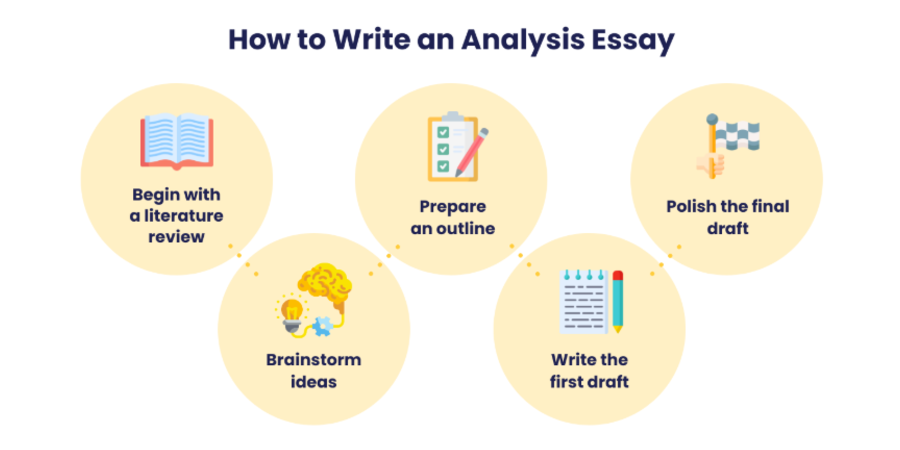An analysis / analytical essay is a standard assignment in college or university. You might be asked to conduct an in-depth analysis of a research paper, a report, a movie, a company, a book, or an event. In this article, you’ll find out how to write an analysis paper introduction, thesis, main body, and conclusion, and analytical essay example.
So, what is an analytical essay? This type of assignment implies that you set up an argument and analyze it using a range of claims. The claims should be supported by appropriate empirical evidence. Note that you need to explore both the positive and negative sides of the issue fully.
Analytical skills are the key to getting through your academic career. Moreover, they can be useful in many real-life situations. Keep reading this article by Custom-writing experts to learn how to write an analysis!
❓ What Is an Analysis Paper?
Before you learn how to start an analysis essay, you should understand some fundamentals of writing this type of paper. It implies that you analyze an argument using a range of claims supported by facts. It is essential to understand that in your analysis essay, you’ll need to explore the negative sides of the issue and the positive ones. That’s what distinguishes an analytical essay from, say, a persuasive one.
We understand that writing an analysis paper can be a complex task since it requires a thorough examination of arguments and opposing viewpoints as well as supporting your own claims. If you find this process overwhelming, an analytical essay writing service can provide invaluable assistance. Our certified experts can help you craft a high-quality and insightful essay that meets academic standards while saving you time and effort.
Analysis Paper Argument
The key to writing an analysis paper is to choose an argument that you will defend throughout it. For example: maybe you are writing a critical analysis paper on George Orwell’s Animal Farm The first and imperative task is to think about your thesis statement. In the case of Animal Farm, the argument could be:
Example:
In Orwell’s Animal Farm, rhetoric and language prove to be more effective ways to keep social control than physical power.
The University of North Carolina at Chapel Hill gives a great explanation of the thesis statement, how to create one, and what its function is.
But that’s not all. Once you have your thesis statement, you need to break down how you will approach your analysis essay to prove your thesis. To do this, follow these steps:
- Define the main goal(s) of your analysis. Remember that it is impossible to address each and every aspect in a single paper. Know your goal and focus on it.
- Conduct research, both online and offline, to clarify the issue contained within your thesis statement.
- Identify the main parts of the issue by looking at each part separately to see how it works.
- Try to clearly understand how each part works.
- Identify the links between the various aspects of the topic.
- By using the information you found, try to solve your main problem.
At this point, you should have a clear understanding of both the topic and your thesis statement. You should also have a clear direction for your analysis paper firmly planted in your mind and recorded in writing.
This will give you what you need to produce the paper’s outline.
You are usually assigned to analyze an article, a book, a movie, or an event. If you need to write your analytical essay on a book or an article, you’ll have to analyze the style of the text, its main points, and the author’s purported goals.
📑 How to Write an Analysis

These are the steps to write an academic paper:
- Review the literature. Before starting any paper, you should familiarize yourself with what has already been written in the field. And the analytical essay is no exception. The easiest way is to search on the web for the information.
- Brainstorm ideas. After you’ve done your search, it is time for a brainstorm! Make a list of topics for your analysis essay, and then choose the best one. Generate your thesis statement in the same way.
- Prepare an outline. Now, when you’ve decided on the topic and the thesis statement of your analytical essay, think of its structure. Below you will find more detailed information on how your paper should be structured.
- Write the first draft. You’ve done a lot of work by now. Congratulations! Your next goal is to write the first version of your analysis essay, using all the notes that you have. Remember, you don’t need to make it perfect!
- Polish your draft. Now take your time to polish and edit your draft to transform it into the paper’s final version.
An outline is the starting point for your work. A typical analytical essay features the usual essay structure. A 500-word essay should consist of a one-paragraph introduction, a three-paragraph body, and a one-paragraph conclusion. Find below a great analytical essay outline sample. Feel free to use it as an example when doing your own work!
Analysis Paper: Introduction
- Start with a startling statement or provocative question.
Example:
“All animals are equal, but some animals are more equal.” Animal Farm abounds in ironic and provocative phrases to start an analytical essay.
- Introduce the work and its author.
- Give background information that would help the reader understand your opinion.
- Formulate a thesis statement informing the reader about the purpose of the essay. Essay format does not presuppose telling everything possible on the given topic. Thus, a thesis statement tells what you are going to say, implying what you will not discuss, establishing the limits.
Example:
In Animal Farm, Orwell uses different irony types to ridicule totalitarianism to manifest its inability to make every member of society equal and happy.
Analysis Paper: Body
The analytical essay structure requires 2-3 developmental paragraphs, each dedicated to one separate idea confirming your thesis statement. The following template should be used for each of the body paragraphs.
- Start with a topic sentence that supports an aspect of your thesis.
Example:
Dramatic irony is used in Animal Farm to point out society’s ignorance.
- Continue with textual evidence (paraphrase, summary, direct quotations, specific details). Use several examples that substantiate the topic sentence.
Example:
Animals are unaware of the fact that Boxer was never sent to the hospital. He was sent to the slaughterhouse. However, the reader and writer understand that this is a lie.
- Conclude with an explanation.
Example:
By allowing the readers to learn some essential facts before the characters, dramatic irony creates suspense and shows how easy it is to persuade and manipulate the public.
Analysis Paper Conclusion
The next four points will give you a short instruction on how to conclude an analytical essay.
- Never use new information or topics here.
- Restate your thesis in a different formulation.
- Summarize the body paragraphs.
- Comment on the analyzed text from a new perspective.
💁 Analysis Paper Introduction Example
You must understand how to compose an introduction to an analysis paper. The University of Wollongong describes the introduction as a “map” of any writing. When writing the introduction, follow these steps:
- Provide a lead-in for the reader by offering a general introduction to the topic of the paper.
- Include your thesis statement, which shifts the reader from the generalized introduction to the specific topic and its related issues to your unique take on the essay topic.
- Present a general outline of the analysis paper.
Watch this great video for further instructions on how to write an introduction to an analysis essay.
Example of an Analytical Essay Introduction
Example:
“Four legs good, two legs bad” is one of the many postulates invented by George Orwell for his characters in Animal Farm to vest them with socialist ideology and control over the animal population. The social revolution on Manor Farm was built on language instruments, first for the collective success of the animals, and later for the power consolidation by the pigs. The novel was written in 1945 when the transition from limitless freedoms of socialist countries transformed into dictatorship. Through his animal protagonists, the author analyzes the reasons for peoples’ belief in the totalitarian regime. In Orwell’s Animal Farm, rhetoric and language prove to be more effective ways to keep social control than physical power.
🏋 Analysis Paper Body Example
The body of the paper may be compared to its heart. This is the part where you show off your talent for analysis by providing convincing, well-researched, and well-thought-out arguments to support your thesis statement. You have already gathered the information, and now all you may start crafting your paper.
To make the body of an analytical essay, keep the following in mind:
- Discuss one argument per paragraph, although each argument can relate to multiple issues
- Strike a balance between writing in an unbiased tone, while expressing your personal opinion
- Be reasonable when making judgments regarding any of the problems you discuss
- Remember to include the opposing point of view to create a balanced perspective
The bottom line is: you want to offer opposing views, but you must pose your arguments so they will counter those opposing views and prove your point of view. Follow these steps when constructing each body paragraph:
- Choose the main sentence. The main or topic sentence will be the first line in your essay. The topic sentence is responsible for presenting the argument you will discuss in the paragraph and demonstrate how this argument relates to the thesis statement.
- Provide the context for the topic sentence, whether it relates to a quote, a specific incident in society, or something else. Offer evidence on who, what, where, when, why, and how.
- Give your analysis of the argument and how it adequately proves your thesis.
- Write a closing sentence that sums up the paragraph and provides a transition to the following paragraph.
Example of an Analytical Essay Body
Example:
Literacy can grant power, provided that there are animals who cannot read or write. In the beginning, the animals’ literacy and intellect are relatively the same. Old Major is the cleverest pig; he is the kind old philosopher, like Karl Marx or Vladimir Lenin. During his retirement, he develops a theory that all humans are the root of evil. His speech was the foundation for the pigs’ assumption of power. They refined his ideas into a new ideology and called it Animalism. They also learned how to read. It allowed the pigs to declare themselves the “mind workers.” Therefore, the pigs’ literacy assured the illiterate animals in their objective superiority.
Meanwhile, as the pigs were the intellectual elite, they were not supposed to work, which raised their social status by itself. Snowball tried to promote education among all the animals, but most of them failed to master the alphabet. This is a metaphor for the general public being predominantly ignorant and easy to manipulate. At the same time, Boxer and other animals that spend most of the day in hard work merely have no time to develop their intellect. Thus, the pigs’ intention to build a school for pig children was highly efficient. Unequal access to education and unequal ability to express one’s thoughts in perspective reinforce the social divide, making the pigs smarter and more powerful and undermining other animals’ self-esteem.
At this point, the pigs resort to propaganda and rhetoric. Squealer uses his oratorical gift to refine the pigs’ message to the other animals. Upon Napoleon’s order, he breaks the Seven Commandments of farm governance. At night, he climbs the ladder to change them, and once even falls from the ladder trying to change the commandment on alcohol. The “proletarian” animals soon forget what the Seven Commandments were like in the first place and are unsure if they have ever been altered. Further on, Minimus writes a poem praising Napoleon. Finally, Squealer replaces the Commandments with a single assertion: “All animals are equal, but some animals are more equal than others.” Language is no longer used to convince. It is used to control and manipulate.
🏁 Analysis Paper Conclusion Example
The conclusion is short and sweet. It summarizes everything you just wrote in the essay and wraps it up with a beautiful shiny bow. Follow these steps to write a convincing conclusion:
- Repeat the thesis statement and summarize your argument. Even when using the best summary generator for the task, reread it to make sure all the crucial points are included.
- Take your argument beyond what is simply stated in your paper. You want to show how it is essential in terms of the bigger picture. Also, you may dwell on the influence on citizens of the country.
Example of an Analytical Essay Conclusion
Example:
Because of everything mentioned above, it becomes clear that language and rhetoric can rise to power, establish authority, and manipulate ordinary people. Animal Farm is the simplified version of a communist society. It shows how wise philosophers’ good intentions can be used by mean leaders to gain unopposed power and unconditional trust. Unfortunately, this can lead to the death of many innocent animals, i.e., people, as totalitarianism has nothing to do with people’s rule. Therefore, language and oratory are potent tools that can keep people oppressed and weak, deprive them of any chance for improvement and growth, and make them think that there is no other possible existence.
Now you are ready to write an analysis essay! See, it’s easier than you thought.
Of course, it’s always helpful to see other analysis essay examples. The University of Arkansas at Little Rock provides some great examples of an analytical paper.
📔 How to Choose an Analysis Paper Title?
Choosing a title seems like not a significant step, but it is actually very important. The title of your critical analysis paper should:
- Entice and engage the reader
- Be unique and capture the readers’ attention
- Provide an adequate explanation of the content of the essay in just a few carefully chosen words
In the Animal Farm example, your title could be:
Example:
“How Do the Pigs Manage to Keep Social Control on Animal Farm?”
Analysis Essay Topics
- Analyze the media content.
- Analyze the specifics and history of hip-hop culture.
- Sociological issues in the film Interstellar.
- Discuss the techniques M. Atwood uses to describe social issues in her novel The Handmaid’s Tale.
- Compare and analyze the paintings of Van Gogh and George Seurat.
- Analysis of Edgar Allan Poe’s The Black Cat.
- Examine the juvenile crime rates.
- Describe the influence of different parenting styles on children’s mind.
- Analyze the concept of the Ship of Theseus.
- Compare and analyze the various views on intelligence.
- Analysis of The Yellow Wallpaper by Charlotte Perkins Gilman.
- Discuss the techniques used by W. Shakespeare in A Midsummer Night’s Dream.
- Analyze the biography of Frederic Chopin.
- Manifestation of the Chicano culture in the artwork An Ofrenda for Dolores del Rio.
- Similarities and differences of Roman, Anglo-Saxon, and Spanish Empires.
- Describe the problem of stalking and its impact on human mental health.
- Examine the future of fashion.
- Analyze the topicality of the article Effectiveness of Hand Hygiene Interventions in Reducing Illness Absence.
- Discuss Thomas Paine’s impact on the success of American revolution.
- Meaningful messages in Recitatif by Toni Morrison.
- Explore the techniques used by directors in the film Killing Kennedy.
- Compare the leadership styles of Tang Empress Wu Zetian and the Pharaoh Cleopatra.
- Evaluate the credibility of Kristof’s arguments in his article Remote Learning Is Often an Oxymoron.
- Analyze genetically modified food.
- Examine the influence of Europeans on Indian tribes in The Narrative of the Captivity and Restoration of Mrs. Mary Rowlandson.
- Describe the rhetoric techniques used in The Portrait of Dorian Gray by Oscar Wilde.
- The importance of fighting against violence in communities in the documentary film The Interrupters.
- Analyze indoor and outdoor pollution.
- Analyze the issue of overprotective parenthood.
- Explore the connection between eating habits and advertisement.
- Discuss the urgence of global warming issue.
- Influence of sleep on people’s body and mental health.
- Analyze the relationship between Christianity and sports.
- Discuss the concept of leadership and its significance for company efficiency.
- Analyze the key lessons of the book Rich Dad Poor Dad by Robert Kiyosaki.
- Examine the specifics of nursing ethic.
- The theme of emotional sufferings in the short story A Rose for Emily.
- Analysis of bias in books for children.
- Analyze the rhetoric of the article Public Monuments.
- Describe the main messages in Jean-Paul Sartre’s Nausea.
- Explore the problem of structural racism in healthcare.
- The reasons of tango dance popularity.
- The shortcomings of the American educational system in Waiting for Superman.
- Analyze and compare Erin’s Law and Megan’s Law.
- Analyze the James Madison’s essay Federalist 10.
- Examine symbols in the movie The Joker.
- Compare the thematic connection and stylistic devices in the poems The Road Not Taken and Find Your Way.
- Describe and analyze the life of Eddie Bernice Johnson.
- Explore the social classes in America.
- Crucial strengths and weaknesses of the main translation theories.
🔗 References
- Elements of Analysis
- How Can I Create Stronger Analysis?
- How to Write a Literary Analysis Essay: Bucks.edu
- Essay Structure | – Harvard College Writing Center
- Analytical Writing: Looking Closely (Colostate.edu)
- Writing an analytic essay – UTSC – University of Toronto
- Organizing Your Analysis // Purdue Writing Lab
- How to Write an Analytical Essay: 15 Steps (with Pictures)





![Short Story Analysis: How to Write It Step by Step [New]](https://custom-writing.org/blog/wp-content/uploads/2020/12/man-sits-end-trolltunga-before-mountains-284x153.jpg)

![Common Essay Mistakes—Writing Errors to Avoid [Updated]](https://custom-writing.org/blog/wp-content/uploads/2020/12/avoid-mistakes-ccw-284x153.jpg)

![Why I Want to Be a Teacher Essay: Writing Guide [2025]](https://custom-writing.org/blog/wp-content/uploads/2020/12/senior-male-professor-writing-blackboard-with-chalk3-284x153.jpg)
![Friendship Essay: Writing Guide & Topics on Friendship [New]](https://custom-writing.org/blog/wp-content/uploads/2020/12/smiley-female-friends-fist-bumping-284x153.jpg)

This resource helps me a lot. Thanks! You guys have great information. Do you think I can use these steps when taking a test? Could it be known as plagiarized if I just copy and paste the information?
Thanks, very good information.
Thanks for learning how to critique research papers in a proper way! This is what I need to cope with this task successfully! Thanks!
How much is an essay, and is there a chance it can be plagiarized?